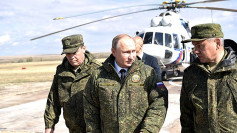The U.S. Army has rapidly accelerated the development of its new "Next-Generation Combat Vehicle" (NGCV) by combining current state of the art technologies with promising future systems instead of building an entirely new armored fighting vehicle (AFV) from scratch.
The Army has also made known its intent to be among the first to adopt self-driving vehicles (or autonomous vehicles) for combat and rear-area use.
NGCV will replace the aging M2/M3 Bradley Fighting Vehicle, which entered in 1981 and has fought in every major U.S. overseas conflict ever since. NGCV is meant to modernize the maneuver force and will carry a nine-man infantry squad, the basic Army maneuver element, into battle against the Russian Army.
The Army wants at least two NGCV prototypes by 2022 and now wants to field this new AFV by 2026 instead of 2035, as originally planned. General Dynamics Land Systems and BAE Systems, the two prime contractors for the NGCV program, are examining several concepts, including those emphasizing maneuver capability over blast protection and dividing the infantry squad into more than one vehicle.
The Army believes that resorting to mature equipment and fast-tracking the NGCV program will speed-up the development effort by nearly a decade.
"Our original vision was 2035," said NGCV Optionally-Manned Vehicle Program Manager Col. Jim Schirmer of the original deadline.
"We now have a challenging test schedule, so we can't afford a clean sheet design. We may need a powertrain and suspension that are already in use somewhere. We need to bring together mature components, with less risk to the schedule."
The Army is trying to do things faster, and this means looking at things now available in the commercial market. It will continue to upgrade its current platforms with anything it may go to war with today. The Army will also continue to make the proper investments in future technologies and future systems so it will have that capability for the war we have to fight after next.
In 2018, however, the Army's NGCV program began seeking defense industry feedback to produce what it calls an "Optionally-Manned Fighting Vehicle" or OMFV.
This AVF is intended as a high-tech, more mobile and more lethal replacement for the Bradley. This AFV will be able to deploy quickly; traverse rough terrain; keep pace with maneuvering infantry and operate with sufficient protection necessary to defeat the most advanced enemy weapons.
Likely to become the first operational NGCV, OMFV will feature turret-launched attack drones for counter air; Intelligence, Surveillance and Reconnaissance (ISR) and land-attack missions. It will also be equipped with advanced Active Protection Systems (APS).
These new APS will use more advanced computer-enabled fire-control and will have advanced radar and interceptor weapons that identify, track and destroy incoming RPGs and anti-tank guided missiles in a matter of seconds, or even milliseconds. The advanced APS might even be able to knock out kinetic-energy penetrator rods fired from enemy high-velocity tank guns.
OMFV is envisioned as an "adjustable" AFV. It might have interchangeable turrets; can be configured with different weapon systems depending upon the mission, and can accommodate sensors or attack drones as needed. OMFV will also be air defense-capable.
Should OMFV operate in a battle space where there are enemy helicopters, drones or aircraft threats, OMFV will be equipped with interceptor attack drones or surface-to-air missiles such as Stingers or Hellfires.






